Garlic is an easy-to-grow plant. There are cases where people haven’t taken much care but still got a harvest. But, the garlic might not be flavorful enough. If you don’t want that to happen, fertilize the garlic plants.
While sowing the garlic pods adding compost works as a great fertilizer to give that initial boost of nutrients. Next, fertilize the garlic plants when scapes appear in spring with a balanced fertilizer (NPK 10-10-10). You can also add organic fertilizer like compost or manure.
In most cases, adding compost or manure is enough. But still, a little bit of fertilizer can help in the production of flavorful garlic. There are many things to know about fertilizing garlic plants. Let’s find out.
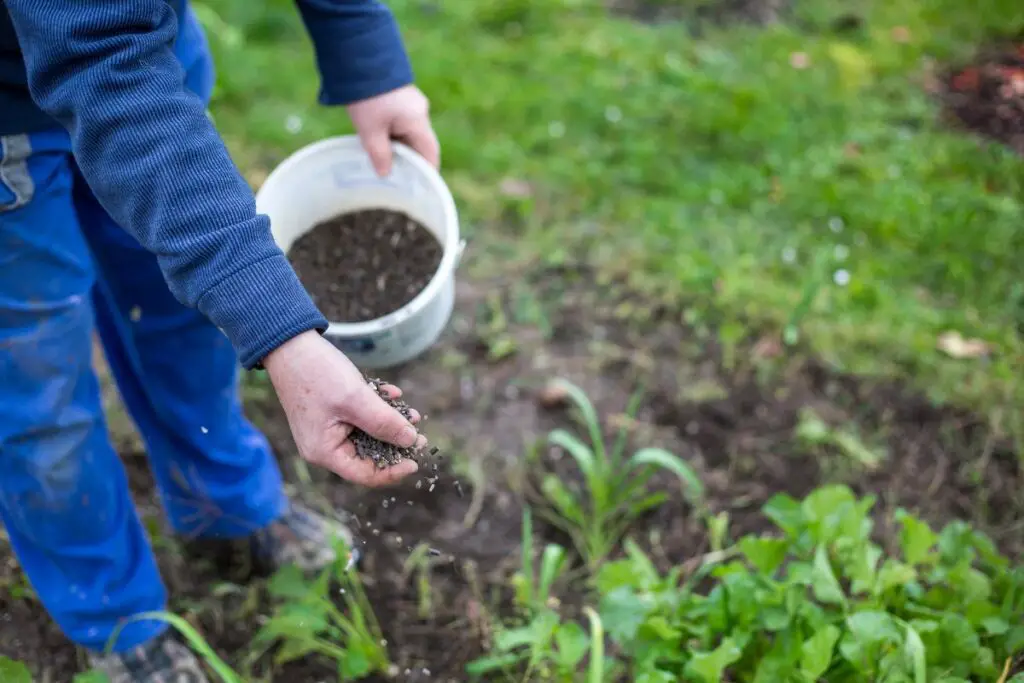
Does garlic need fertilizers?
Garlic is a heavy feeder.
It needs a lot of nutrients to become bigger, tastier, and healthier.
Most gardeners only add compost or manure during planting to increase the soil quality and fertility and don’t fertilize further.
Though compost or manure helps add enough nutrients to the soil, you need to apply fertilizers when the scapes appear.
Only compost or manure doesn’t have all the nutrients garlic needs.
Some commercial soil contains fertilizers.
But they don’t remain for a very long time.
Besides, it might not contain correct and useful nutrients for garlic plants.
That is why you should not skip fertilizing your garlic plants.
When and how often should you apply fertilizer?
First, apply compost to the planting bed before planting garlic.
Also, perform a soil test.
If you have not done any soil tests, fertilize the garlic plants with a balanced fertilizer with compost.
It will give them support in root and new leaf development.
You can also fertilize with a bone meal once to promote flowers.
You can use that flower stalk for proper bulb development.
After that, if you have planted garlic in the fall, the next best time to fertilize garlic is in the spring.
Choose a fertilizer rich in nitrogen and use it over the whole bed.
For side-dressing, allow the fertilizer to work around 1 inch down or 3-4 inches from the plant.
Apply this fertilizer every 3-4 weeks in the spring and summer.
When the plant is at its initial stage, use more nitrogen and less potassium.
Once the plant grows bigger, use more potassium but less nitrogen.
Just before the bulbs begin to swell, fertilize once more but lightly.
Stop using fertilizers rich in nitrogen after that.
High nitrogen can reduce the bulb size and increase leaf growth.
Use bone meal or kelp.
Don’t use too much bone meal as that can promote flowering, which you won’t want.
In the winter, garlic will become dormant.
So, don’t apply any fertilizer at that time.
You can also skip watering.
Just add some mulch to preserve the moisture.
While applying fertilizer individually, you should include potassium, phosphorus, and sulfur in the soil before planting.
Apply nitrogen in breaks after planting.
Apply ⅓rd at the time of plating and ⅔rd during the growing season in the early spring.
After that, apply nitrogen every 2-3 weeks until you see the scapes.
In short, fertilizer application should be scheduled into 3 parts:
- The first application should be done before planting.
- The second application is done during spring to encourage new leaf and bulb growth.
- Do the third application after every 3-4 weeks.
Factors to consider while choosing a fertilizer for garlic
Before you purchase fertilizer for garlic plants, a few things require consideration.
Test your soil
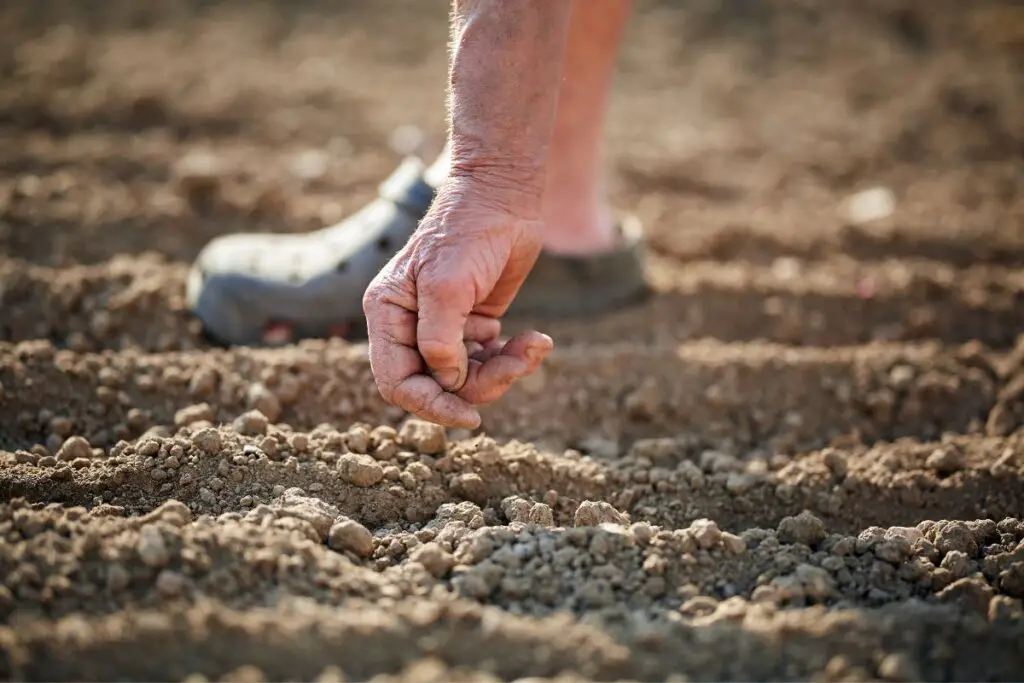
Before applying fertilizer, you should know what nutrients the plant lacks.
Only then should you buy fertilizer and apply it.
You have to conduct a soil test to know what nutrients are present in the soil.
Next, you have to conduct a test for pH level.
Fertilizers can mess up the pH levels.
So, you should know about it.
Nutrients
To buy a good fertilizer, you have garlic’s essential nutrient requirements and whether those nutrients are present in the fertilizer or not.
Some essential nutrients are:
- Carbon dioxide: received from the air
- Hydrogen: received from water
- Oxygen: received from air and water
Other essential nutrients are:
- Nitrogen: for fast growth
- Phosphorus: to stimulate root growth
- Potassium: to make the plant drought and disease resistant
- Magnesium: to process the sunlight better
- Sulfur: to give the plant more protein
Other minor nutrients required by garlic are copper, iron, zinc, boron, manganese, chlorine, etc.
NPK Ratio
Now that you know what nutrients are essential, you should also understand the number of nutrients needed.
Whenever you buy fertilizer, it has an NPK ratio. NPK stands for nitrogen(N), phosphorus(P), and potassium(K).
Fertilize the garlic plants with a fertilizer with an NPK value of 16-6-4.
Garlic requires nitrogen to increase the plant’s output and boost the bulb size and quality.
It would be best if the nitrogen-rich fertilizer contains guano, bone meal, blood meal, and alfalfa.
These can improve the plant’s lifespan and make it resistant to diseases.
When the plant grows bigger, apply a fertilizer low in nitrogen and high in potassium.
At the planting time, use an all-purpose balanced fertilizer with NPK 10-10-10 or 19-19-19.
Looking for gardening supplies? We have tested 100's of products before recommending them to you guys. Check out our best pick below:
| Image | Gardening Supplies | Best Price? |
|---|---|---|
 Top
Top Top
Top | Raised Garden Bed Kit | Check On Amazon |
 | XLUX Soil Moisture Meter, Plant Water Monitor, Soil Hygrometer Sensor for Gardening, Farming, Indoor and Outdoor Plants, No Batteries Required | No Results |
 Top
Top Top
Top | 82 Pcs Garden Tools Set and Extra Succulent Tools Set | Check On Amazon |
 | Joeys Garden Expandable Garden Hose with 8 Function Hose Nozzle, Lightweight Anti-Kink Flexible Garden Hoses, Extra Strength Fabric with Double Latex Core, (50 FT, Black) | No Results |
 Top
Top Top
Top | Dual Chamber Compost Tumbler | Check On Amazon |
 Top
Top Top
Top | Sunnyglade Plant Stakes | Check On Amazon |
 Top
Top Top
Top | Organic Cold Pressed Neem Seed Oil | Check On Amazon |
 Top
Top Top
Top | Mighty Mint Gallon :-Insect and Pest Control Peppermint Oil | Check On Amazon |
 Top
Top Top
Top | Scotts DiseaseEx Lawn Fungicide | Check On Amazon |
 Top
Top Top
Top | Jacks Classic 20-20-20 All Purpose Fertilizer | Check On Amazon |
 Top
Top Top
Top | 30,000 Seeds Pollinator Attracting Wildflower Mixture | Check On Amazon |
 Top
Top Top
Top | Survival Vegetable Seeds Garden Kit-Over 16,000 Seeds | Check On Amazon |
Fertilizer type
- Use Miracle Gro Performance Organics All Purpose Plant Nutrition Granules to feed your plants, flowers, vegetables, and herbs
- The shaker jug makes feeding in-ground and container plants easy
- In as little as 7 days youll start to see results (vs unfed plants)
- Enjoy Miracle Gro results with organic, all natural ingredients
- Reapply every 4 to 6 weeks and water regularly for best resu
Before buying a fertilizer, you must understand what fertilizer can be useful for garlic plants.
Granular fertilizer is a dry fertilizer applied by spreading around the plant base.
One advantage is that you can see where you have applied it and where it is needed.
It can be both slow-release and quick-release.
Slow-release will release the nitrogen gradually. You need to apply it one 1 to 2 times per year.
Quick-release immediately spreads nitrogen, acts faster than slow-release, and requires more than one application.
Liquid fertilizers also start to act instantly.
You need to dilute it before application. You can apply it with a hose, watering can, or canister.
But one disadvantage is that it gets washed away faster, especially during the rains.
So, it is better to apply them when there is no rain.
Spikes are stick-type fertilizers and a slow-release.
These are easy to apply as you can directly put some spikes into the ground.
It is good for beginners.
Organic or inorganic
Fertilizer comes in two more types – organic and inorganic.
Both work well.
But if you are a beginner, you should first begin with organic fertilizers.
Inorganic or synthetic fertilizers release nutrients faster and act faster.
You should apply it during the spring.
It comes in liquid, granular, or spikes.
On the contrary, organic fertilizers release the nutrients slowly.
You can apply them in the fall.
The advantage here is that organic fertilizer is less harmful.
What is the best fertilizer for garlic?
There are many suitable fertilizers for garlic.
They come in organic, store-bought, natural, and compost manure.
Compost and manure
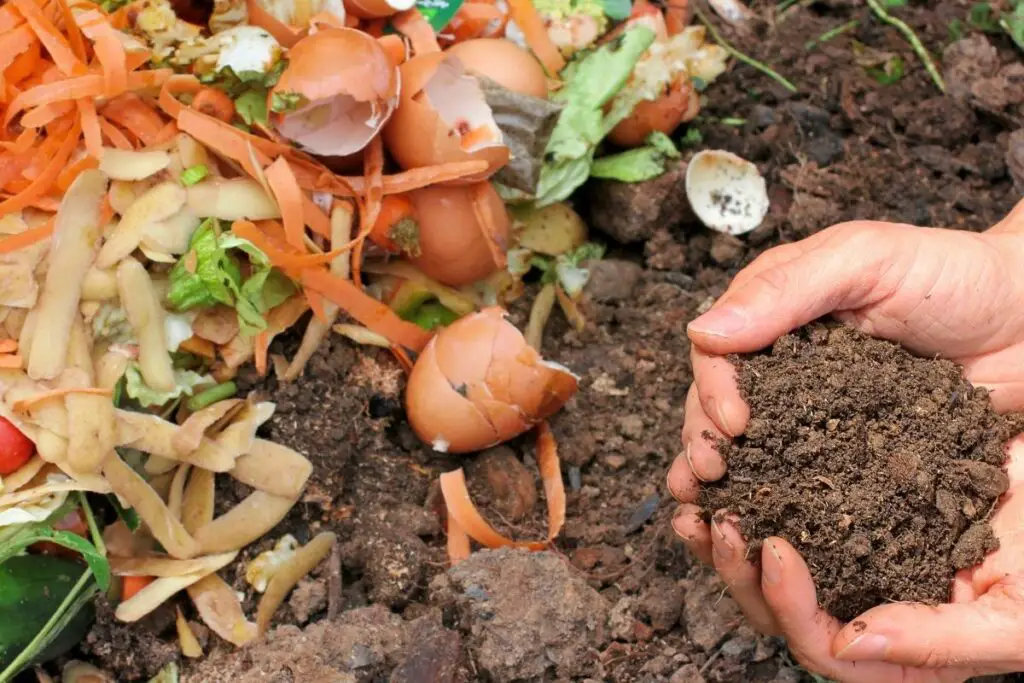
Compost and manures are a great source of fertilizer.
But, they don’t have too much nitrogen.
So, you need to apply them in huge quantities to meet the plant’s needs.
While using compost and manures, many gardeners use amendments to fulfill the plant’s phosphorus, sulfur, and potassium needs separately.
Whatever you prefer, make sure that garlic gets maximum nutrition throughout its growing season.
Compost
Compost is usually a mixture of green and brown composting material.
Make a pile in similar layers of green and brown composting materials.
Make sure to cut them into pieces for faster decomposition.
Now, sprinkle some water over each of the layers.
You can also add some compost intake into the water.
Now, turn them for 3 days using an aerator tool and let them stay for a few months.
It is ready for application when the compost darkens and doesn’t smell.
Well-rotted manure
Before planting the garlic cloves, add rotted manure or compost.
Proper preparation of the soil prevents additional fertilizer application.
Fresh cattle and horse dung
You can use fresh cow or horse dung to the soil bed in doses of 40-80 tons for each hectare.
Pig manure
Pig manure is another useful manure.
Add this only under the previous crop in 40 tons for each hectare.
Goat manure
This manure is dry and has less smell than the other manures.
Besides, goat manure is easy to apply.
Goat manure makes fertilizer faster than the others.
It also contains more nitrogen than the other manures.
Half-decomposed manure
You can use half-decomposed manure of cattle in 40-60 tons per hectare doses.
You can use it after clearing the forerunner and for initial plowing only.
You can also use fresh manure in the same situation if you use poor sandy loam soil.
Organic fertilizers
Fish emulsion
Use fish emulsion once a month in the spring, and stop using one month before you plant to harvest garlic.
Bone meal
- STRONGER ROOT DEVELOPMENT
- Bone meal fertilizer breaks down slowly, releasing nitrogen for robust growth throughout the season.
- ORGANIC CERTIFIED: OMRI listed for organic gardening.
- IDEAL FOR FALL BULB PLANTING
Adding it while planting in the fall encourages better bulb development.
It also releases the nutrients slowly throughout the winter.
Blood meal
Add it into the soil before planting for slow-release of organic nitrogen.
Humus
Add humus during the first deep cultivation.
Apply 30-40 tones for each hectare before planting the garlic.
Liquid organic fertilizers
Seaweed or fish emulsion
Add 1 tablespoon of liquid seaweed to 1 tablespoon of fish emulsion and mix them with 1 gallon of water.
This liquid fertilizer helps in better blub development.
Avoid using very high nitrogen fertilizer.
That will encourage huge plants but small bulbs.
Homemade fertilizers
Epsom salt
Sprinkle some Epsom salt over every square meter of the soil bed.
Wood ash
Add some wood ash before planting into the ground.
Use 150-200 kg per hectare.
Use it again in the mid-spring, along with some seaweed or comfrey.
But if your garlic plants are doing fine, you don’t have to bother them for the second time.
Natural fertilizers
Straw
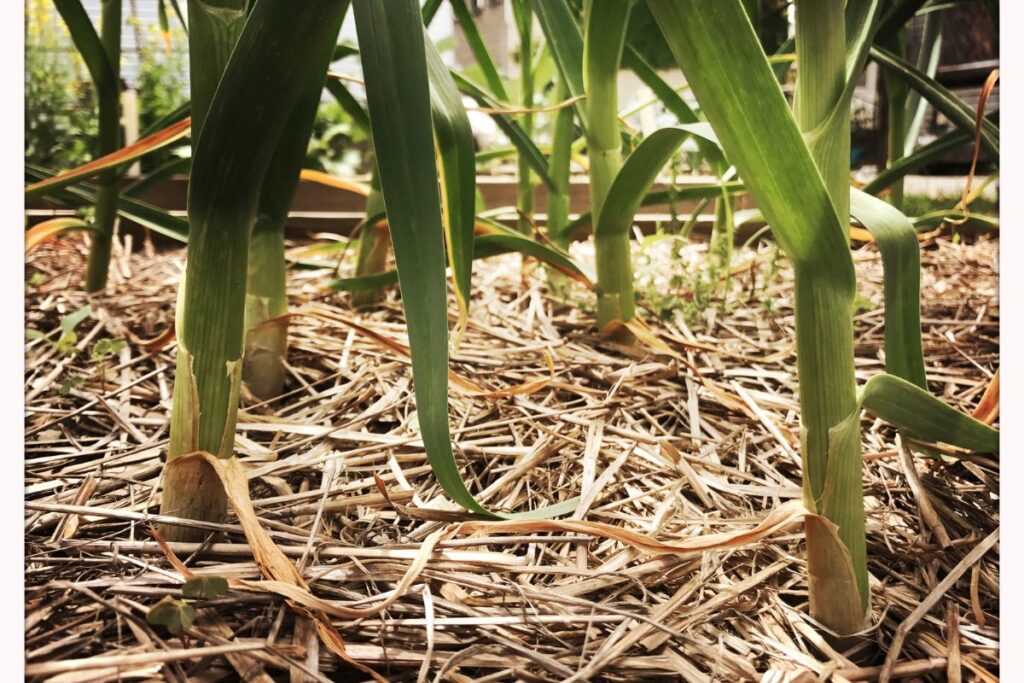
Mulch your garlic bed around with a thick 4-6 inches layer of straw or leaves during the winter.
Mulching will protect the cloves from the winter freeze.
Are coffee grounds good for garlic?
Coffee grounds have been one of the famous homemade fertilizers used by most gardeners.
Coffee grounds are rich sources of nitrogen which is good for garlic plants.
It also helps in good growth.
Besides, coffee grounds can also adjust the soil’s pH levels and increase acidity levels.
Coffee grounds are used as fertilizers or compost.
So, instead of throwing the used coffee grounds in the trash, add them to the compost bin.
Though coffee grounds are a good nitrogen source, it contains only 2% of nitrogen.
Increasing the acidity level depends on factors like roasting timing, brewing, and fineness of the coffee grounds.
In general, coffee grounds have a pH value of 4.85-5.10.
Once it gets used or brewed, it gets neutralized. The pH level remains around 6.5.
How to use coffee grounds for garlic?
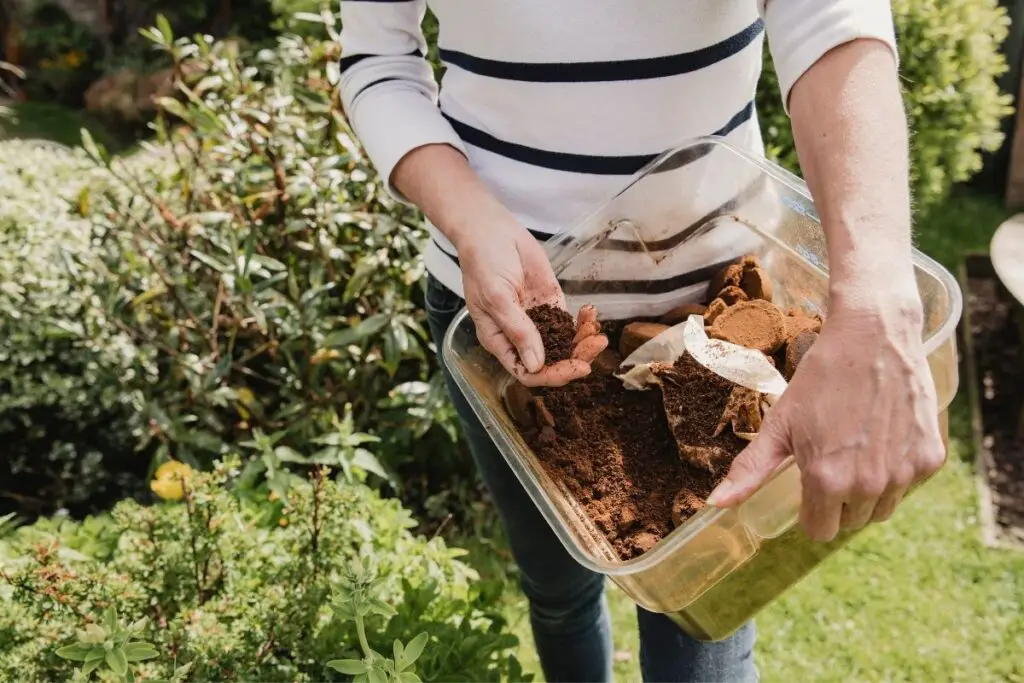
As compost
For making an ideal compost with coffee grounds, add ⅓rd of each coffee ground, grass/fruits/vegetable peels, and mulch.
Now, add one handful of soil.
Mix them very well and let them age for 2-3 months.
Now, spread them around 5-6 inches over the soil or raised beds.
As fertilizer
You can add the ground directly to the soil.
Though composting is better, the direct application won’t make the soil enriched with nitrogen within one night.
For using coffee as fertilizer, first:
- Spread half or one inch of the grounds over the bed.
- Add some nitrogen fertilizer.
- Mix them well and spread 4 inches of mulch like moss, grass clipping, pine, or leaves. Mulching will help in faster decomposition and nitrogen release.
Use used coffee and not fresh coffee here.
Fresh coffee to adjust the acidity level
Direct application of fresh coffee grounds works better for garlic.
Its acidic nature can make the soil acidic.
Add the fresh coffee grounds over the soil bed and around the plant or clove.
Remember that the pH level of garlic is between 6 and 7.
Be careful while applying it.
Garlic is sensitive to both too much acidity and alkalinity.
Coffee grounds get neutralized only when they are used.
Otherwise, fresh coffee is acidic enough.
How to apply fertilizer for garlic?
There are several ways to apply fertilizer.
Before planting
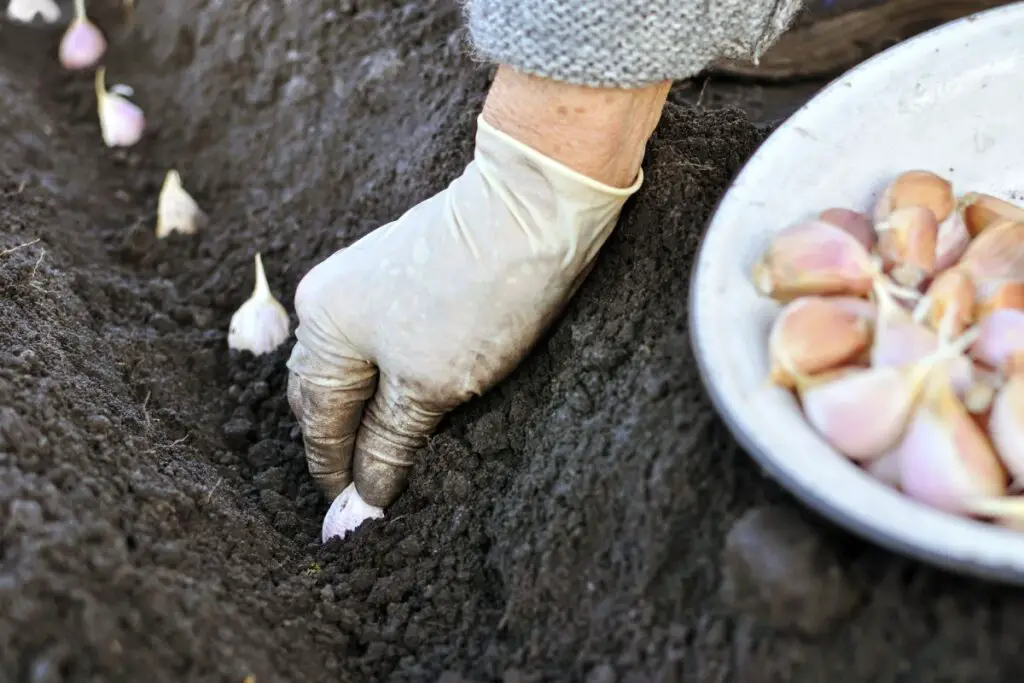
Apply some fertilizer to the soil first.
Then till the soil to work the fertilizer into the soil.
Then plant your garlic cloves and water the soil properly.
Re-apply the fertilizer every 4-6 weeks.
Row application
This application is also done before planting.
Apply the fertilizer in a strip over the side of the row before planting.
After that, plant the cloves to let the plants have the nutrients from the soil.
Adding solution to the soil
You can do this if you want to transplant your plant.
Make a hole in the soil and add some fertilizer to it.
Then, shift your plant to that hole.
Water the plant to activate the nutrients.
For growing plants
This application is for the already growing plants.
Apply the fertilizer around the plant and then water the soil well to activate the nutrients.
Fertilizer applications depend on the type.
If you are using granules, dig a hole, add a little bit of fertilizer, water it well, and then plant the cloves in that hole.
You can also sprinkle some around and water the soil well.
If you are using liquid fertilizer, dilute them with water and then apply it as you water your plant.
Use a garden hose or a watering can.
If you use spikes, push the sticks directly to the ground and water your plant.
Some commercial fertilizers
- Our best formula, fortified with 11 essential nutrients
- Works with virtually all plant varieties, in all growing conditions
- Feeds up to 6 full months
- Apply with confidence to potted plants, indoors or outdoors
- No-burn pledge when used as direc
If you don’t have much time to search for the right fertilizer, you can choose the fertilizers with an ideal NPK value.
Some ideal commercial fertilizers are:
- Miracle-Gro All-purpose Plant Food: Apply it every two days. NPK – 24-8-16.
- Osmocote Flower and Vegetable Plant Food: It lasts up to 4 months. NPK – 15-9-12.
- Old Farmer’s Almanac Vegetable Fertilizer: Can be used for 250 sq. ft. It lasts for 8 weeks and comes in NPK 8-4-8.
- Dr. Earth’s Vegetable Fertilizer: Contains probiotics and seven different microbes. It has all the essential nutrients. NPK – 4-6-3.
Some commercial organic fertilizers include:
Seaweed
- Neptune’s Harvest Organic Hydrolized Fish and Seaweed fertilizer
- Liquid Kelp Organic Seaweed fertilizer
Best Bone Meal
Best Blood Meal
Best soil amendment fertilizer
Results of over-fertilization and under-fertilization
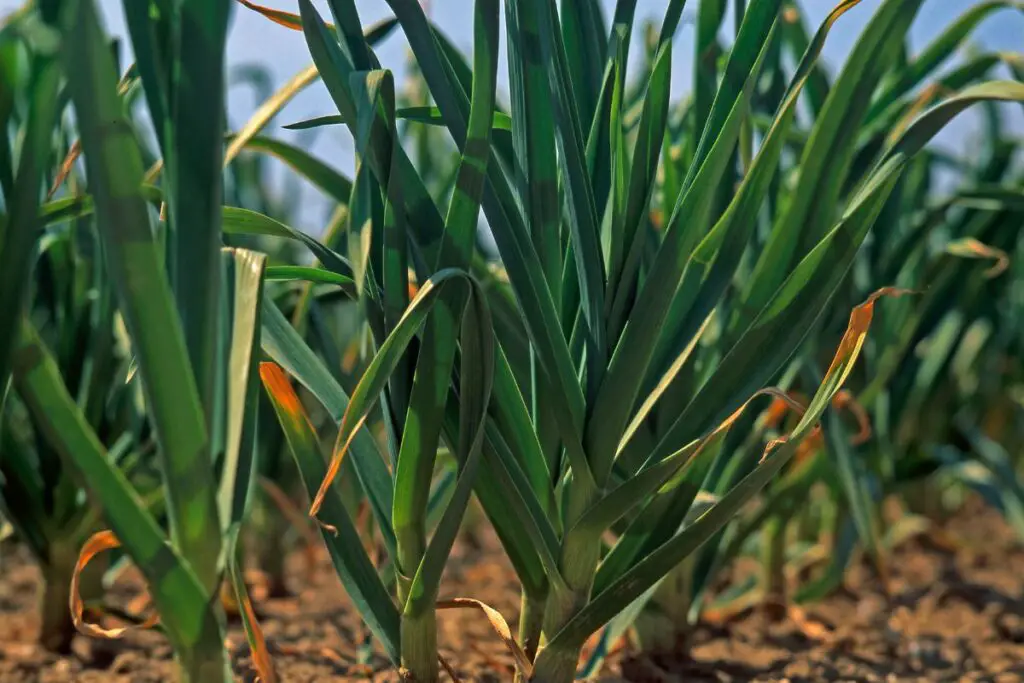
Both excess use and underuse have some bad effects.
Garlic is a heavy feeder. So, never skip fertilizing.
But at the same time, if you over-fertilize them, it will give rise to other situations.
Under-fertilization
When you don’t fertilize the garlic plants or the soil, it can display signs:
- There will be no growth of the bulbs.
- No heads will emerge.
- Even if it emerges, the bulbs will be smaller and tasteless.
As a beginner, if you’re confused about using store-bought synthetic fertilizers, try composting and organic fertilizers.
If you find any stressful signs, test your soil to understand what nutrients it requires.
Start with composting.
Over-fertilization
Just because garlic is a heavy-feeder doesn’t mean you should constantly feed them without maintaining any routine or following proper gapping.
Despite being heavy feeders, garlic can also suffer from overfeeding.
Signs of over-fertilization are:
- Small bulbs
- Excess leaf growth in the plant
- Leaf burns, especially in the young plants, due to an overdose of synthetic fertilizer or fresh chicken manure
When you find any such signs, shift your garlic to another location.
Water the soil thoroughly to bring down the nutrient concentration.
Stop fertilizing for some days or weeks.
Send your soil for a test to confirm whether the plant is ready for fertilizing or not.
Avoid using synthetic fertilizers for some weeks.
Final thoughts
Garlic plants are heavy feeders. So, never miss fertilizing. But also make sure not to overfeed them.
Fertilize them in breaks – before planting, in spring, and then 3-4 weeks. Avoid winter fertilizing. Use nitrogen-rich fertilizer initially and then slowly reduce nitrogen when the plant grows bigger.
There are multiple options for choosing the best fertilizer. Use the recommended ones in the article or ask the seller for better consultation. While using the synthetic fertilizers, read the instructions carefully on the label.
Reference: The Pennsylvania State University, Garlic Production for the Gardener, University of Massachusetts Amherst, Ohio State University Extension.



